Guide around the Archaeological Section
The first room, dominated by mighty stone statues, is dedicated to the most ancient traces of human presence.
In the first case on the right, the ‘Serra d’Alto’-type vase is to be found – discovered in the Basso Sarca area, but of South Italian production - testifying to the wide-ranging contacts that took place between different communities, also on a local level, as far back as the Neolithic age.
The cases along the wall house a number of articles in split fl int, found at a great altitude (1,100-1,500 metres) on Monte Baldo, considering that at the time the surrounding area was covered by glacier. A number of items can be traced to the middle Palaeolithic period (120,000-33,000 BC), to the late Palaeolithic as well as to the Mesolithic, and were made by the Neanderthals who, being hunters, were forced to stay on the move in order to exploit the resources offered by the environment. Then, with the improvements in the climactic conditions - around 18,000 years ago - the late Palaeolithic and Mesolithic hunters were able to push into the mountain plains. Traces of their passing have been found around Alpine lakes and near mountain passes.
After the 9th millennium BC, the milder climate led to a gradual transformation of the environment towards conditions more akin to those of the present day. The Mesolithic human dwellings became more stable, and were established largely in the sheltered areas between the large cracks which opened up along the sides of the valley floor.
Man trasforms his environment
Then we come to the objects that tell us about the Neolithic period. At this time, people’s livelihood was still based on hunting and gathering, but little by little, farming and livestock started to make their appearance, leading to a greater stability of human settlements and the establishment of more complex societies.
Many of the materials on display were part of the funeral rites – which took place in lythic cist-type burial structures – consisting simply of axes and blades of sharpened stone, fl int arrowheads, ceramic containers, tools and ornaments made of bone, as well as necklace parts made out of seashells (Spondylus), further proof of the far-ranging trade made by these lake-dwellers. Other items are in miniature, used only for burial purposes.
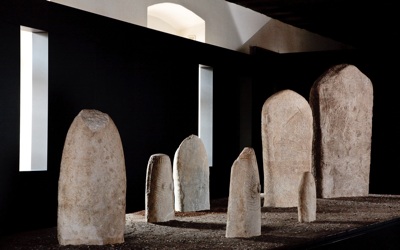 |
The stone statues |
|
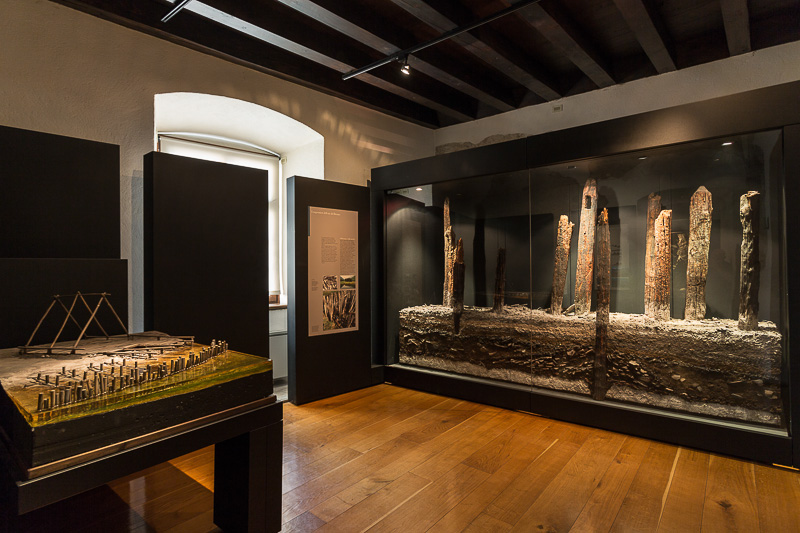 |
A world on water As our visit continues, we enter a space dedicated to the stilt-house settlements of Molina di Ledro and Fiavè Carera, which developed in Trentino during the Bronze age (2,200-1,000 BC). In the glass cases, we may see objects of everyday use in clay and metal, as well as highly prestigious articles such as crowns, amber pearls, and the so-called “enigmatic tablets” of Ledro. The richness and the abundance of the materials discovered in the stilt houses afford a wide-ranging and detailed reconstruction of these people’s way of living, showing an articulate social structure and an economic independence based on forms of handcrafts of a largely domestic nature. The remarkable building skills of the Bronze Age carpenters are to be seen from the complex types of stilt-house foundation structures which came to light in Fiavè and which are visible from the reconstruction. |
|
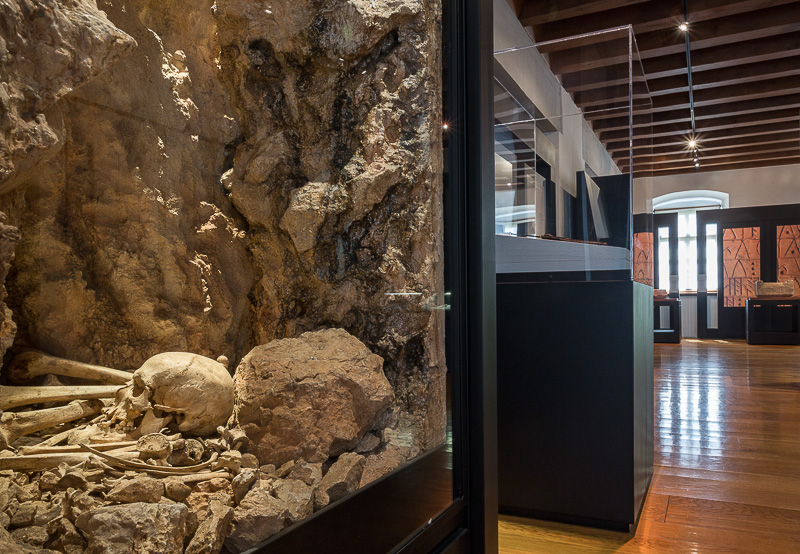 |
The Man of the Busa Brodeghera: hunting accident or human sacrifice? Moving on to the next room, we fi nd ourselves faced with a striking reconstruction of the Busa Brodeghera, discovered on Monte Altissimo at 1950 metres above sea level. It is a narrow ravine, some 70 metres deep, at the bottom of which was found the skeleton of a man of around 20 years of age, who had a number of objects with him dating back to the 5th-4th century BC. The man had a limp and his head was wounded, perhaps the cause of his death. His possessions included a knife sheath, identical to the one found on a fragment of a situla urn from Welzelach in Austria. We cannot say with any certainty exactly what led this young man into the Busa Brodeghera. He is believed to have been a hunter, having fallen accidentally. However, it cannot be ruled out that this discovery might not have something to do with some cult rituals such as human sacrifi ce, or with some particular form of burial. |
|
|
Offerings to the Gods of water and the rites of fire |
||
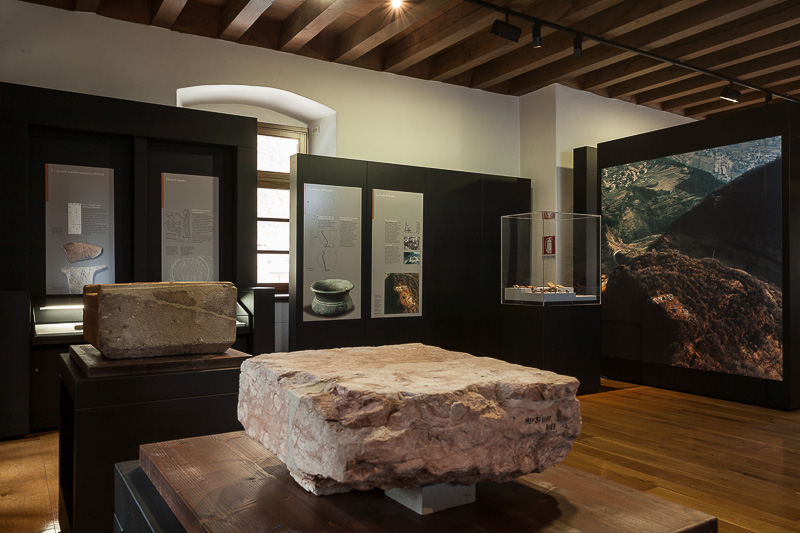 |
The archeological area of San Martino We then reach the section dedicated to the Monte San Martino site, which seems to serve as a link between Rhaetian culture and the Romanisation process. This was an important place of worship, frequented during the later Iron Age (especially between the 4th-3rd centuries BC and the early 1st century BC) and the following Roman Age, when it was transformed into a proper sanctuary. In the cases on the right, we fi nd a number of fragments of cups and jugs, which are of enormous importance in identifying the cultures of the populations that came to this site. Among the precious materials found, those bearing written documentation testify to the delicate transition stage from the indigenous Rhaetic language and alphabet, of which traces may be found carved onto a number of ceramic fragments, to the Roman phase with its Latin inscriptions present in the epigraphs on display. During the pre-Roman age, the evidence that we have suggests that there was a religious culture based around goddesses who protected the land and fertility, generally expressed through the offering of agricultural produce. This preference for female godheads was then passed on to the Roman cult, as shown by the lead statue of mother and child, the bronze depiction of Isis-Fortune and the two clay fi gures of Venus and Minerva which may be seen in the cases. |
|
|
The sacred area |
||
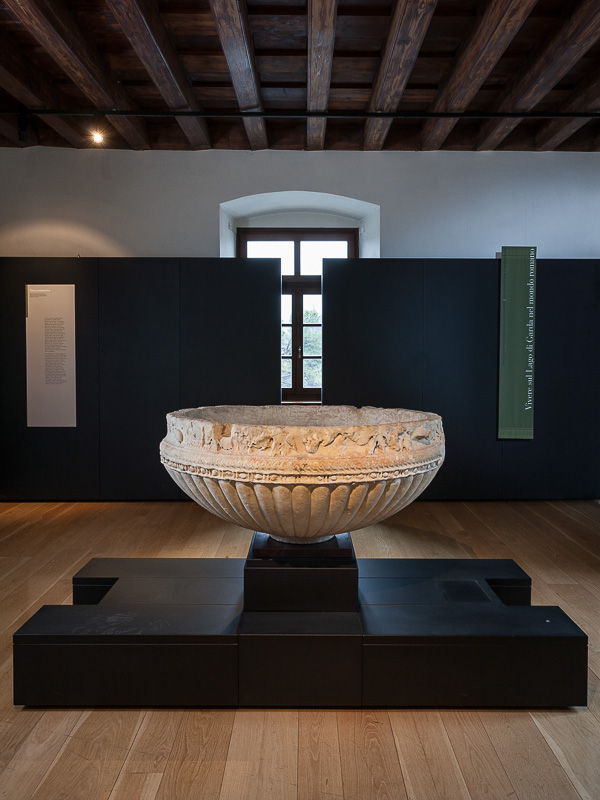 |
The roman world Once we have passed on to the third room, we may admire the splendid marble tank in the Hellenist tradition (late 1st century AD), also of enormous artistic value, demonstrating how the northern Garda territory is surely one of the key sources of artefacts from the Roman age in the whole of Trentino. The recent discovery of the thermal baths (1st century AD) in the centre of Riva, has led us to presume that the tank was once part of this structure, as well as the existence of a settlement on the northern shore of lake Garda. We are now in the space dedicated to the settlers in the area around the Basso Sarca and the changes made to the territory in the Roman period. In particular, a certain amount of attention is paid here to the themes of land division of the inhabited areas (at least nine different settlement areas), and the numerous necropolises (more than 25), from which the funeral monuments and precious accompanying objects displayed in the cases come from. The archaeological section comes to a close with a number of late-classical and high-mediaeval items also taken from burial grounds. As far as this period is concerned, the information we have access to is somewhat lacking, limited as it is to religious and sepulchral contexts, although the research carried out around the area of San Cassiano has proved to be of fundamental importance in the study of this period. The recent discoveries made in viale Dante are also of particular importance in this matter. They show the presence of a 1st-century AD necropolis as well as a second one, largely of infants, dating back to the end of the 7th-early 8th century AD, which appears to have been erected alongside a place of worship on a paved road - running East-West - and next to residential-type buildings. |
|




